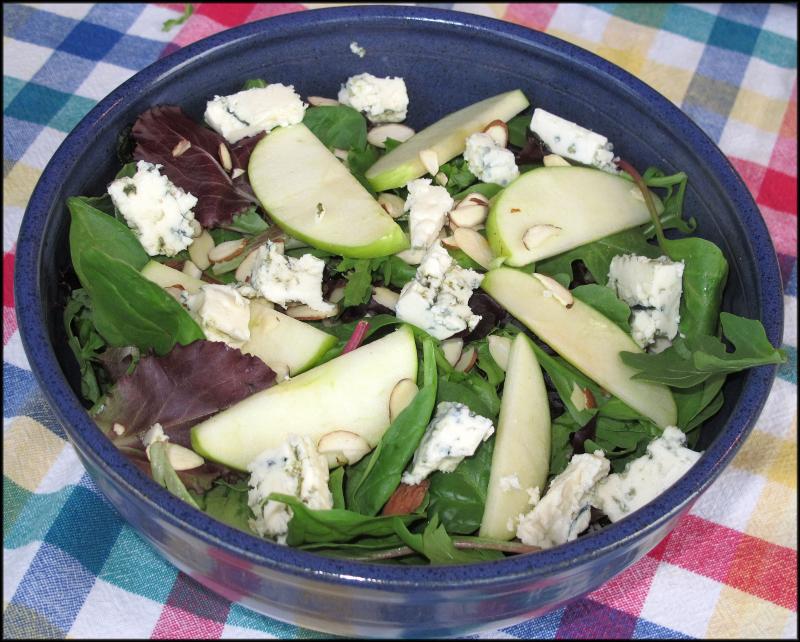Share:
Apples (and apple recipes) a sure sign of autumn
September 20, 2019
If you’ve been to a farmers market or your local grocery lately, you’re seeing one of the sure signs of autumn – apples. There’s an array of colors and shapes, from the misnamed Delicious to the green Granny Smith, juicy Gala and chubby McIntosh. One of the more preferred newcomers to the apple scene is the Honeycrisp, which has grown in popularity since its introduction in 1991.
The Honeycrisp variety was developed by the University of Minnesota and has become a new favorite. It’s known for its sweet tartness and firm, juicy texture. Unlike other hybridized fruits and vegetables designed for long-term storage and hardiness for shipment, these were bred solely for their impressive taste.
One feature of the apple-breeding process that may come as a surprise is that once growers have a desirable cultivar, they apply for a patent to protect the fruit’s unique genetics and its descriptive name. To meet market demand during the U.S. off-season, growers in New Zealand have created their version of the Minnesota invention, trademarked as HoneyCrunch.
Different apples are appropriate for different recipes, and knowing which ones to choose can help improve your results. For example, if you want an apple to eat out of hand, select a Honeycrisp; if you’re baking a pie or tart and don’t want too much juice, consider a Braeburn. For a salad or cheese plate, the Cortland works well because its flesh doesn’t brown and discolor as quickly.
Fuji apples are firm, crisp and juicy, holding their shape as they cook and making them ideal for a tarte tatin. Galas are a great choice for applesauce, while Granny Smith will give your dish spicy, tart notes that work beautifully with creamy cheeses. McIntosh can be a bit watery when cooked and often work better when paired with Golden Delicious in pies.
When you bring your fresh apples home from the market, store them in a cool, dry place. If you keep them in the crisper drawer, arrange them in a single layer so they don’t touch each other. Keep them away from more delicate produce like lettuce, as the apples naturally release ethylene gas which will hasten ripening and spoiling of what’s nearby.
Once you’ve decided which apples to select, you can put them in a variety of dishes, starting with the salad in the photo. Here, we’ve tossed spring mix with chunks of blue cheese, thinly sliced Granny Smith apples and crisp almond slivers. You can easily substitute baby arugula for a sharper bite in the greens. For sweeter notes, add dried cranberries. The salad shown hasn’t been dressed yet, but it’s delicious with creamy blue cheese dressing.
There are any number of ways to make applesauce, from a quick stovetop simmer to hours in the slow cooker. If you’re going to use a food processor or immersion blender to mash or purée the cooked apples, you’ll want to peel them first. If you’re planning to use a food mill, you won’t need to remove the skins; just be sure to cut the apples into consistent chunks so they cook evenly. Add lemon juice, a couple of cinnamon sticks and grated nutmeg for flavoring.
We’ll often garnish a sandwich with sliced tomato, so why not substitute thin slices of apple instead? The combination of Granny Smith or Cortland apples with brie and Dijon mustard will bring a baguette immediately to life. And for a twist on potato soup, consider this recipe that combines Yukon Gold potatoes and Fuji apples with a pinch of paprika and hints of sage.
Slow Cooker Applesauce
6 Gala apples
1/4 C orange juice
2 cinnamon sticks
1 T lemon juice
1/4 t grated nutmeg
Peel the apples. Quarter them through the stem, then cut out out the cores. Coarsely chop the apples into 1-inch pieces. Place all the ingredients in a slow cooker and stir to combine. Cover and cook on the high setting for 4 hours, stirring once or twice during cooking. Transfer mixture to a serving dish and remove cinnamon sticks. If you prefer chunky applesauce, mash slightly with a potato masher. If you prefer a smoother texture, use an immersion blender to purée the applesauce. Allow the applesauce to cool to room temperature. Store in airtight containers in the refrigerator.
Apple Brie Sandwich
6-inch section of baguette
2 t Dijon mustard
2 oz brie cheese
1/2 Cortland apple
Slice the baguette in half lengthwise. Spread mustard on cut sides. Slice brie 1/4-inch thick and arrange on bottom half of baguette. Remove the core and cut the apple into thin slices; arrange in a single layer over the cheese. Cover with the other half of the baguette and cut in half diagonally. Yield: 2 sandwiches.
Apple Potato Soup
1 t olive oil
1 Fuji apple, peeled and diced
3/4 C peeled, diced Yukon Gold potatoes
1/3 C diced onion
1/4 C thinly sliced celery
1/4 t salt
1/4 t sage
1/8 t paprika
1 1/2 C vegetable broth
1/4 C sour cream
Heat oil in a medium saucepan. Add apple, potato, onion and celery; cook, stirring often, until onion is translucent, about 5 minutes. Stir in salt, sage and paprika; cook for a minute or so. Pour in broth and bring to a simmer. Reduce heat, cover and gently simmer until the potato is tender when pierced with a fork, about 12 minutes. Purée the soup with an immersion blender or in a food processor. Whisk in sour cream and serve. Yield: 4 servings.
























































